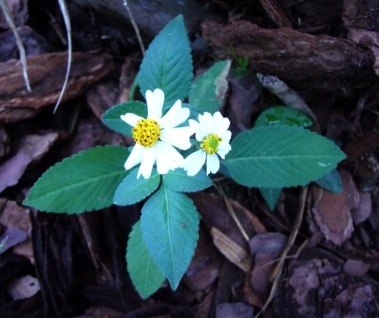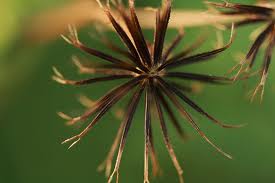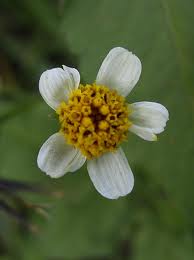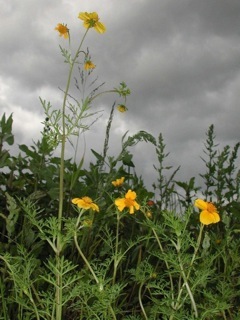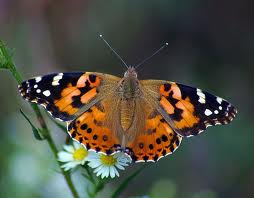Bidens Alba: Medical Beggar Ticks
Some edible plants just don’t get any respect. If there were a contest for under appreciated plants, Bidens alba, would be a heavy-weight contender.
Nearly anyone you ask about Bidens alba who knows it will say it’s a weed, not a pretty one, nor a useful one, not a nice one. Yet, honey production everywhere would be hurt without the Bidens family. In Florida, B. alba is the third most common reliable source of nectar. Quite an accomplishment for a weed growers and suburbanites are constantly trying to get rid of. Also, without the Bidens species many a butterfly would go to bed…ah…roost… hungry. (The second most common nectar producer in Florida is the saw palmetto and the top producer is the non-native, citrus which Greening might kill off.)
The B. alba aka Bidens pilosa (BYE-denz AL-bah, pil-OH-suh) also has an edible flower. It’s a tangy if not vigorous addition to salads. Bidens’ young leaves — a few at a time — are suitable for the salad. Shoots, tips and young leaves are good potherbs. It’s dried leaves are also a favored in Hawaii for tea. All of this, yet few guidebooks on wild edibles mention it.
TIMEOUT: Much confusion reigns whether B. alba and B. pilosa are the same or different species. One can find both references, and combinations as in B. pilosa var. alba. A 2006 genetic study showed they are separate species, even if
the difference is little. So, how can we tell them apart (though it makes little difference as both are eaten.) B. alba is the larger and better (I use “Big Al” to help me remember.) Its blossom petals are usually a centimeter long or longer, and it has five to eight petals. Think of the B. pilosa as smaller and lesser. Its petals are under a centimeter in length, usually 8 mm or less. It has four to seven petals, or none at all. Some times the geography helps. In Brazil, for example, B. alba grows only on the coast and B. pilosa inland, at higher elevations. Realistically, the differences mean little to us as they are both edible. Locally we have B. alba with B. pilosa occurring officially in only one northern county, Gulf County. We now resume our article already in progress:
As I said on one of my videos nature doesn’t know the difference between a cultivated plant and a wild one: She only knows survivors. And Bidens alba — also called Romerillo — survives. It grows so happily in my yard I can’t keep up with it. Left to its own, it will take over any unmown spot and populate it with as many Bidens per square foot as possible. Now you know why it is called an “invasive” species. It can have up to 6,000 seeds per plant and the seeds can remain viable up to five years.
As for the edibility of the Bidens species, several are mentioned as edible. Find out which Bidens are in your area. The state of Florida does not list Bidens as a plant species that can cause harm, though it has had medical uses, and that in and of itself is a warning sign we shouldn’t ignore. There are at least two negative references I know of about Bidens pilosa. One is that B. pilosa is one of the few plants that can have a harmful effect on the skin because at least one of its chemicals reacts to light (some herbalists, however, consider that beneficial.) The other is B. pilosa (which is the most commonly eaten Bidens) may have a role in throat cancer in areas where opals are also found. This is because B. pilosa will uptake a form of silica — the same that creates opals — and that can have a topical cancerous effect. So if you have “Opaline Silica” in your area — they mine opals there — you might want to pass on the Bidens (I would presume B. alba would also uptake but I do not know.) On the other hand, however, Bidens is also shown anti-cancer activity.
Bidens is in the Aster family, a dicot with a root that goes vertical, not horizontal. That also makes it a composite and a relative of the sunflower. There are hundreds of species — authorities differ on the exact amount. The common names include beggar ticks, bur-marigolds, stickseeds, Spanish needles, tickseeds, tickseed sunflowers, and pitchfork weed. This is because its seed has two prongs on it that (sometimes four) stick to almost anything. And in fact “Bidens” means two-toothed. Alba is white and pilosa means hairy, or the feeling of hairiness. The Bidens odorata, a frilly yellow version, is also edible though it is a diuretic.
By the way, Bidens are “zoochorous” which means the seeds are spread by animals, like the burdock. While the combination does not loose in translation from Greek, it does suffer in pronunciation. “Zoo” is not said like a collection of animals. Rather it is zoh-OH, which means “animal.” And “chorous” does not sound like a singing group. It comes from the verb score-REE-zoh, which means “I disseminate.” So, if you want to use that word and be close to the original Greek, it is five syllables: zoh-oh-score-REE-zoh.
Several Bidens are food for the caterpillars of some Lepidoptera, such as the Hypercompe hambletoni and the Painted Lady (aka, Vanessa cardui, the brush-footed butterfly). It is said only Sulphur Butterfly feeds off the B. alba as it has phytosterin, which can be a central nervous system depressant and lowers blood sugar.
As for the medical implications, in 1991 Egyptian researchers documented Biden pilosa had antimicrobial activity against a wide array of bacteria including Salmonella, Staphylococcus, Neisseria Gonorrhea, Klebsiella Pneumonia, and against Tuberculosis. It is also good for malaria, snake bite and has anti-leukemia activity. Research shows it lowers as mentioned blood sugar and blood pressure, stimulates the immune system and is anti-inflammatory. The powdered seeds are a topical anesthetic and aid clotting. There are also some reports the seeds might be good for prostate issues and use for lungs affected by COVID. And after all this the Bidens still gets no respect.
These’s between 240 and 280 known Bidens. Why they don’t know exactly how many Bidens there are is because of multiple and perhaps unnecessary names and or varieties. The nutritional composition of the Biden pilosa (and presumably the B. alba) per 100 g edible portion is: water 85 g, calories 43, protein 3.8 g, fat 0.5 g, carbohydrate 8.4 g, fiber 3.9 g, β-carotene 1800 μg, (Leung, W.-T.W., Busson, F. & Jardin, C., 1968). Another study found 111 mg of calcium and 2.3 mg of iron. These researchers also recommend you don’t eat the leaves raw because of a high saponin content. As a potherb they are excellent with many fine qualities: They are available all year round, keep very well, and don’t reduce in size when cooked. If they are a bit tangy, just let them sit cooked a few minutes. They store well. Cooked texture is good. Wine made from Bidens is called sinitsit. Incidentally, dried leaves of the B. Alba also make a good tobacco substitute. In 1962 Professor Julia Morton, who wrote many papers for the Journal of Economic Botany, recommended Bidens become a commercial crop.
B. pilosa also has 60 identified flavonoids including Quercetin and Luteolin. Among the micro nutrients are beta-carotene 1800 μg (which is pre-vitamin A) calcium 340 mg, phosphorus 67 mg and 2.3 mg of iron when dried. (Food Composition Table for Use In Africa, Leung, W.-T.W., Busson, F. & Jardin, C., 1968) Interestingly the dried plant has less calcium (111mg) and phosphorus (39) than the raw material. Usually dried “tea” material increases concentrations.
There are many edible Bidens and they grow just about everywhere so check out your local species. Those with edible leaves include Bidens bipinnata, Bidens frondosa, Bidens odorata, Bidens parvifolia, Bidens tripartita and Bidens laevis. Leaves of the Bidens aurea and Bidens bigelovii have been used for tea.
Synonyms for the Bidens Alba/Pilosa include: Bidens abortiva, Bidens adhaerescens, Bidens alausensis, Bidens chilensis, Bidens hirsuta, Bidens leucanthus, Bidens Montauban, Bidens odorata, reflexa, Bidens scandicina…. and….Bidens leucantha var. pilosa, Bidens pilosa var. alausensis, Bidens pilosa var. bimucronata, Bidens pilosa var. minor, Bidens pilosa var. pilosa, Bidens pilosa var. radiata, Bidens pilosus, Bidens pilosus var. albus, Bidens scandicina, Bidens sundaica var. minor, and Coreopsis leucantha
Green Deane’s “Itemized” Plant Profile
IDENTIFICATION: Compound leaves composed of 3-9 saw toothed oval leaflets. The leaves are one to five inches long and up to two and a half inches wide, bright green on top and hairy underneath. Plant tends to sprawl and root at the lower nodes if it touches the ground. The one-inche flowers in stalked clusters look like coarse daisies with five or more white rays and pale yellow centers. The ribbed seeds resemble flat black needles with 2-6 barbed hooks at each end.
TIME OF YEAR: Spring to fall, but year round in warmer climates around the world
ENVIRONMENT: Not fussy about soil but prefers full sun.
METHOD OF PREPARATION: Young leaves, tops, shoots as potherb. Some young leaves can be used raw in salads. Try a little first. Flower petals as a trail side nibble or a bit of white in salads. Dried, the leaves can be used as tea or smoked like tobacco. The flowers are mixed with sticky balls of rice and allowed to ferment in water to make a spirit. The leaves are also used in making wine.

